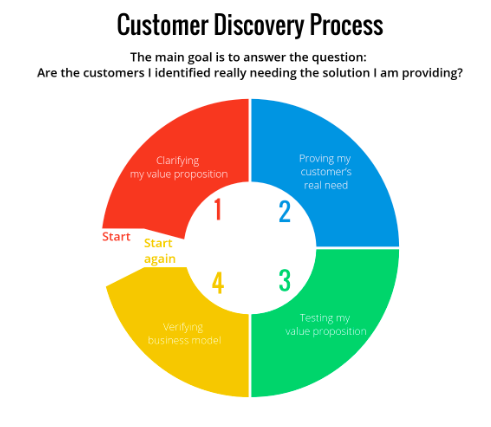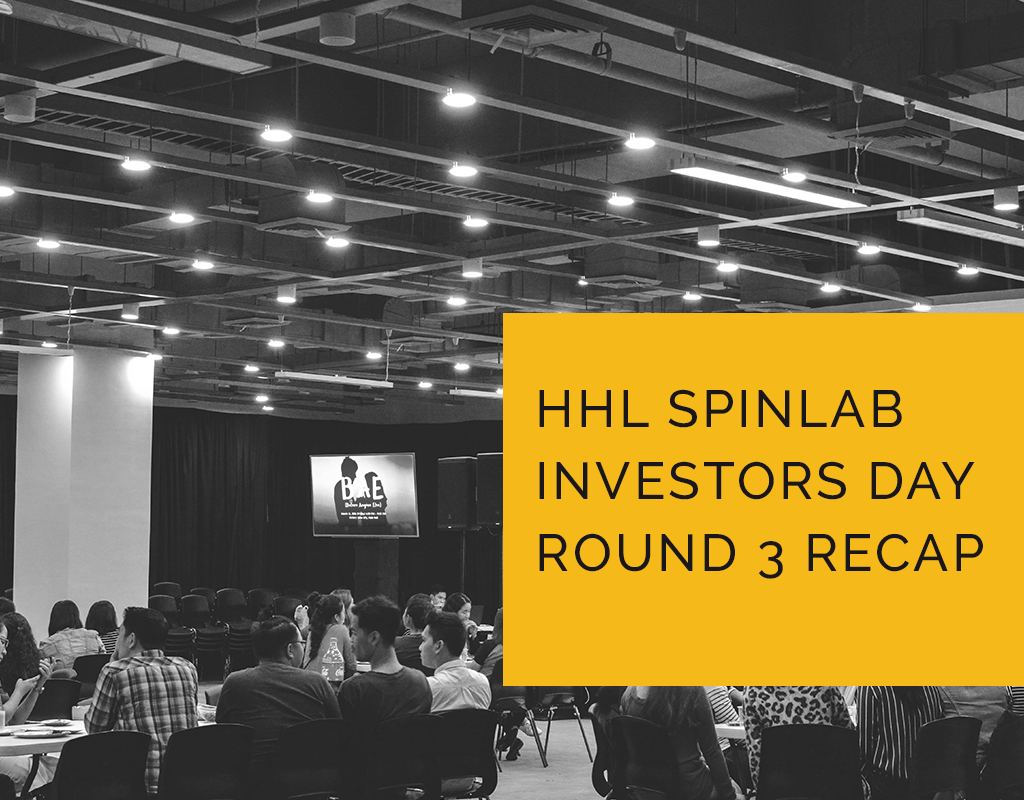The first article in this series has given you an insight into finding your internal values to define your external value proposition. In this article, you will learn how to find customers. Steven G. Blank, a renowned entrepreneur, worked out central questions that he discovered when observing start-ups while acquiring new customers:
- Where is our market?
- Who are our customers?
- How do we build the right team?
- How do we scale sales?
He developed a model on how startups can build their sales process while focussing on the customer which he called the Customer Development model. The four steps are Customer Discovery, Customer Validation, Customer Creation, and Company Building. These steps should give companies a guideline of how to make their market entry.
4 Techniques to best discover your customers
Most of what the founders of startups know at the beginning about their market and potential customers are just “educated guesses”.
To improve the probability of having a profitable company in the future, you have to turn those guesses into real facts. The only way of doing it is going outside, where the customers really are and proving they do have a real vision.
Yes, you really have to get out of your comfort zone or ivory tower and talk to people. While doing this, you also have to answer the question Are the customers you identified really needing the solution you are providing? You need to prove whether the problem, product, and customer you indicated in your business plan are correct. To make it easy, we will break it down into four easy steps:
Clarifying my value proposition: What am I offering as a solution?
During this step, you have to write your hypothesis about the product, customers, pricing, demand, market, and competition that you will test in the following steps.
Proving my customer’s real need.
Get outside of your workplace and face reality. Focus on little talking and a lot of listening. Understand the real problem of your customer. Here you are going to test your problem hypotheses.
Listen, discover how the customers work and what their key problem is. These should not be sales-oriented conversations. Once finished, you go back to your company and integrate everything you have learned.
Revise your customer and product assumptions again and provide feedback to the engineering team based on what you learn. At this point, don’t adjust your product, but your hypotheses and story.
Testing my product
Can my product actually solve this current situation my customer is facing? Here the goal is not to sell but having the desired response “yes, that solves our problem”.
Meanwhile, you are also proving the validity of your whole business model. You discover if the customers are willing to pay for the product and who the person is, that is really paying for them (Direct and indirect customer). You also test your price, your channel strategy, sales process, and sales cycle.
Verification
Check that you understand the needs of your client and that it matches with the solution you are developing. Knowing this ensures that the customer is willing to pay for it and your business model is profitable.

Customer Discovery Process Outputs
After going through this whole process you should be able to deliver the following outputs:
- A problem statement document
- An expanded product requirement document
- An updated sales and revenue plan
- A solid business and product plan
Now you are able to decide whether you have learned enough and you want to start selling to your selected visionary customers or you need to go back and get more insights.
To put it in a nutshell, regardless of market type, all startups should “leave the building and talk to customers”. Develop a product for the few, not the many! Do not try to develop a product with so many features requesting a long period to be ready and for sure getting to the market just when the technology is already obsolete.
Better focus on small groups of customers known as Evangelist. Those who will not only spread the good news about your product but also buy it.
The goal of the Customer Discovery process is not to come up with a new set of features. Remember you are not running focus groups.
New features are only necessary if the customers consistently say that there is no real problem, the problem is insignificant, or they think that the current specifications of the product do not solve their problem.
The key to success is not trying to find the product customers are looking for but discovering the customers for the product you are already developing.
For the communication within your team, it is essential to talk about the findings during the customer discovery process and match it with product development.
Only when both teams, product development, and customer discovery, are on the same page, it is a good idea to move forward with customer development.
Validating your assumptions
Theoretically, you are good to go, but now it gets serious. In this second step, you now actually have to have your first customers, make your first sales and validate your educated guesses.
The goal is to define a viable and effective Sales Roadmap, setting the path that the sales and marketing teams have to follow. You need to prove the accuracy of your business model, verifying your market, location of your customers, testing the value the customers give to your product, identifying the economic buyer, defining the price and the channel strategy, and checking your sales cycle and process.
It sounds like a lot of steps to take, but they will all flow naturally when you start to sell based on your assumptions and the assumptions you did in the previous step.
Pay attention to this: This is the moment that proves whether your assumptions are correct before you spend too much money. And if you are right, this is the moment to set the pivot.
“Creating” new customers
Now it is all about execution and creating end-user demand which will likely create demand into the company’s sales channel. After your startup had its first customer, you can now start to spend money on your startup’s marketing strategy.
This process of Customer Creation varies with the type of startup and the type of market you are selling to. The marketing expenditure focus is not the same when you sell to a market already well defined by the competitors than when you are creating a totally new market.
Building the company
With a valid sales story and a growing marketing channel, you now can focus on expanding your company.
Company building is the transition from its informal, learning, and discovery-oriented Customer Development team into formal departments with e.g. VPs of Sales, Marketing and Business Development. Now it is all about scaling the organization and operation to excel with your business. Easy, isn’t it?
Of course, you have to question yourself, how you want to structure the teams. What is the culture of my company? Is it competitive or collaborative? How senior are my employees? Which kind of structure could resemble my company? Would it come to frictions when I change my processes due to structural changes?
Either you could work in independent, adaptive, linkable but swappable kind of pods, where employees work together on closing customers or you could also set it up like an assembly line, with a specialized position for the different stages within the funnel. Either way, there has to be a mapping between your internal culture and the skills your employees have.
It is all about data
Make sure, that you gather all the information you get throughout the whole customer development process.
Gather them in a way, that helps you to reveal weak spots in your value proposition, sales story and process and also your product development.
Talk about your little wins as well as about your failures. Your founder vanity should not hinder your startup’s progress. That is also the awesome thing about data: It’s mostly objective. So don’t take it personally, that your number of successful talks is to low. The only person being responsible for this is you.
What about the Golden Circles and summary?
Several parallels can be identified when comparing Simon Sinek’s model to the Customer Discovery model.
Most importantly, the Customer Discovery model indeed covers the What and How circles of Sinek's golden circle method by defining the value proposition by clearly addressing the problem that needs to be solved and defining, how and why your solution differs from the market. Nevertheless, it does not include the essential Why circle of Sinek.
Therefore, the two methods can be used simultaneously in order to get the best out of both methods and generating a solid, sophisticated value proposition and the first idea of communicating it.
In addition, the Customer Discovery model is more about applying what you think might work. So deploying both models, one for strategy and one for operation in the early stages is highly recommended.






/RootCamp_Logo-Ecosystem.png?width=200&name=RootCamp_Logo-Ecosystem.png)
/Bitroad_Logo-Ecosystem.png?width=200&name=Bitroad_Logo-Ecosystem.png)



/White%20Versions/stadt_leipzig_white.png?width=130&name=stadt_leipzig_white.png)
/lfca_white.png?width=119&name=lfca_white.png)

/White%20Versions/sachsen_signet_white.png?width=65&height=79&name=sachsen_signet_white.png)